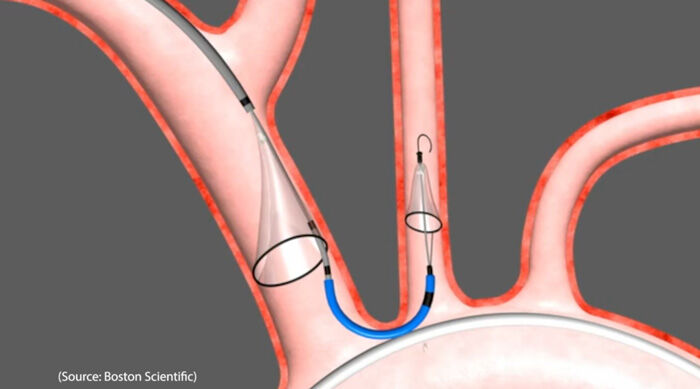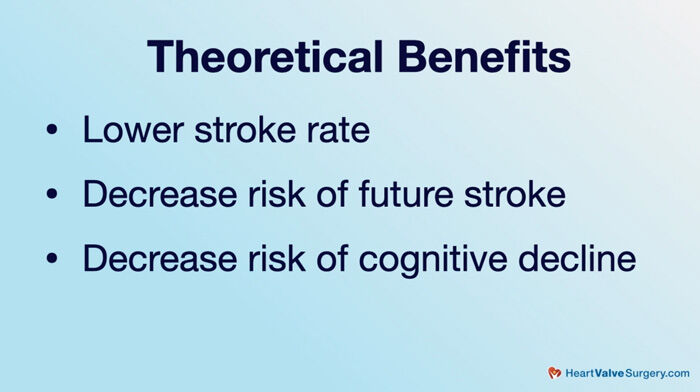Stroke Risk & TAVR: What Should Patients Know About Cerebral Protection Systems?
Written By: Adam Pick, Patient Advocate & Author
Medical Expert: Isaac George, MD, Surgical Director, Structural Heart Disease, NewYork-Presbyterian Hospital
Published: August 10, 2022
While transcatheter aortic valve replacement (TAVR) is considered one of the most transformational advances in heart valve therapy of the past 20 years, there remains an ongoing patient concern about stroke risk during this non-invasive procedure.
For example, I just received a great question from Deb who asks, “I’m looking into TAVR and recently learned about an FDA-approved system to use when placing a TAVR to prevent plaque from breaking off, traveling to the brain, and causing a stroke. It is called SENTINEL Cerebral Protection System. Are any physicians you know using the SENTINEL while implanting a TAVR aortic valve?”
To learn more, we met with Dr. Isaac George, the Surgical Director of Structural Heart Disease at NewYork-Presbyterian Hotel in New York City. During his career, Dr. George has performed over 6,000 TAVRs and successfully treated many patients in our community including Patrick Purcell and Rita Guaraccina.
Key Learnings About TAVR & Stroke Risk
Here are important insights about TAVR, stroke risk and the SENTINEL Cerebral Protection System from Dr. George:
- Using a shared decision making approach that considers the lifetime management of heart valve disease, Dr. George uses a variety of treatment options including TAVR and surgical aortic valve replacement (SAVR) depending on their disease, their risk factors and their lifestyles.
 Dr. Isaac George (TAVR Expert)
Dr. Isaac George (TAVR Expert)
- According to Dr. George, the stroke risk for patients undergoing TAVR is 1.5% to 2.5%. “Stroke is a persistent issue in TAVR,” states Dr. George. “Calcium can break off at multiple time points during the procedure. Regardless of what we’ve done, better devices, more experience, stroke is a fixed commodity in terms of this procedure. That’s why it’s such a big deal.”
- The SENTINEL Cerebral Protection System is designed to minimize stroke risk during TAVR. The SENTINEL uses filters (or basked) that are temporarily implanted in the patient’s body to collect calcium debris during TAVR. This is a filter that’s inserted in the right radial artery at the time of TAVR and removed at the end of the procedure,” states Dr. George. “In theory, it has two baskets that collect any debris that’s liberated during the time of TAVR.”

- The theoretical benefits of the SENTINEL include: (i) lower stroke rate, (ii) decrease risk of future stroke and (iii) decrease risk of cognitive decline.
- According to Dr. George, about 20% of cardiac centers use the SENTINEL Cerebral Protection System. The reasons for why cardiac centers do not use the SENTINEL include cost and conclusive evidence that the SENTINEL reduces stroke during TAVR, according to Dr. George.

- In September, 2022… At the upcoming Transcatheter Cardiovascular Therapeutics (TCT) conference being held in Boston, the results of the PROTECT TAVR clinical trial are expected to be released. The PROTECT TAVR clinical trial was designed to demonstrate that SENTINEL significantly reduces the risk of peri-procedural stroke (≤72 hours) after TAVR. Dr. George states, “The next set of data that’s going to be coming out at TCT 2022 will be the PROTECT TAVR trial, which aims to definitively show that cerebral protection filters reduce stroke. We are very anxiously awaiting that study result.”
Many Thanks to Dr. George, Columbia University Medical Center and NewYork-Presbyterian Hospital!
On behalf of our patient community, many thanks to Dr. Isaac George for sharing his clinical experiences and research specific to TAVR and stroke risk. We also want to thank the entire Columbia University Medical Center and NewYork-Presbyterian Hospital teams for taking such great care of patients with heart valve disease.
Keep on tickin!
Adam
P.S. For the deaf and hard of hearing members of our community, I have provided a written transcript of my interview with Dr. George below.
Video Transcript:
Adam Pick: Hi, everybody. It’s Adam with heartvalvesurgery.com. Today we’re answering your questions about stroke risk and transcatheter aortic valve replacement. I am thrilled to be joined by Dr. Isaac George, who’s the Surgical Director of Structural Heart Disease at NewYork-Presbyterian Hospital in New York City. During his fantastic career, Dr. George has performed over 10,000 cardiac procedures and more than 6,000 TAVRs. Dr. George, it is great to see you. Thanks so much for being here today.
Dr. George: Thanks, Adam, great to be here. Thanks for having me on. Great to see you.
Adam Pick: Dr. George, before we get to the patient’s question, I want to talk to you about your specialty there at NewYork-Presbyterian Hospital in New York, which is TAVR. Can you share with the patients why this has become such an important part of your practice?
Dr. George: TAVR has really been an important part of my practice, my philosophy, my education here. I started out as a cardiac surgeon practicing open cardiac surgery. I spent a lot of time as TAVR was evolving, going into the depths and the expertise in structural heart disease, specifically transcatheter heart valves. It was a blooming field at the time. I’ve really devoted myself to learning all of these techniques so I can understand each patient separately, understand what’s important for them, and be able to use all of these therapies to make the best decision for any individual patient. That can include open cardiac surgery. That can include transcatheter valve. It can include a mix and match of both of them. Some patients can get surgery and then get TAVR. Some patients can get TAVR and then get surgery. All of these are tools that we use as physicians to hopefully make the best decisions to treat patients over their lifetime.
Adam Pick: Dr. George, I loved your utility of shared decision making, the mix and match and tailoring procedures over a patient’s lifetime. Now let’s get to the patient’s question. This comes in from Deb. She asks, “I’m looking into TAVR, transcatheter aortic valve replacement, and recently learned about an FDA-approved system to use when placing a TAVR to prevent plaque from breaking off, traveling to the brain, and causing a stroke. It is called Sentinel Cerebral Protection System. Are any physicians you know using the Sentinel while implanting a TAVR aortic valve?”
Dr. George: Deb hits it right on the butt. We have about 20% of operators and centers in the United States right now using the Sentinel Cerebral filter protection device. This is a filter that’s inserted in the right radial artery at the time of TAVR and removed at the end of the procedure. In theory, it has two baskets that collect any debris that’s liberated during the time of TAVR. Stroke is a persistent issue in TAVR. Calcium can break off at multiple time points during the procedure. That stroke rate is still between 1.5 to 2.5%, regardless of what we’ve done, better devices, more experience. It’s a fixed commodity in terms of this procedure. That’s why it’s such a big deal. We can’t predict it well.
We clearly know that patients that have more calcium have a higher risk of stroke. We also know that almost a hundred percent of patients who undergo TAVR have liberated calcium and debris that go up to the brain. That’s found on MRI and other imaging studies in patients in clinical trials. The Sentinel filter is a device, again, that’s been used to reduce the volume of those debris that go up to the brain. There are a lot of theoretical benefits – potential a lower stroke rate when you look at pooled studies together. It can maybe decrease the risk of future stroke and the risk of cognitive decline. In conclusion, we do use the filter here at our center. We use it on almost every case if the anatomy is usable.
Adam Pick: Dr. George, thanks for sharing that information about the Sentinel. One question I’m sure patients are wondering, with only a 20% utility of the device, why aren’t more centers using it to help patients?
Dr. George: There are a few reasons, Adam. The first is cost. It does cost extra to use the device. There are some reimbursement add-ons that help mitigate that cost. However, it doesn’t fully change that. We’re going to see more conclusive evidence, because the second reason is that we don’t have conclusive evidence that it reduces stroke. Stroke is a very challenging thing to study in clinical trials. One, you have to figure out who actually has the stroke and who doesn’t, so it requires specific neurologists and experts to come and evaluate patients. It also requires very expensive imaging tests such as MRIs and CT scans. The next set of data that’s going to be coming out at TCT 2022 will be the Protect TAVR trial, which aims to definitively show that cerebral protection filters reduce stroke. We are very anxiously awaiting that study result.
Adam Pick: Dr. George, no doubt we will be looking forward to the results of that clinical trial. On behalf of all the patients at heartvalvesurgery.com, thanks so much for taking time away from your busy practice there at NewYork-Presbyterian Hospital and sharing this educational information about TAVR. Thanks so much for being with us.
Dr. George: Thanks very much, Adam. It’s been a pleasure being on. We look forward to the next time.
Adam Pick: Hi, everybody. It’s Adam. I hope you enjoyed that video. Don’t forget you could always subscribe to our YouTube channel. Watch the next two educational videos coming up on your screen or click the blue button to visit heartvalvesurgery.com.


